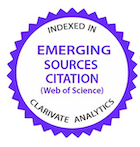Anatomia do nervo facial em lobo-guará (Chrysocyon brachyurus - Illiger, 1815)
DOI:
https://doi.org/10.1590/1809-6891v21e-59079Resumo
O Lobo-Guará (Chrysocyon brachyurus) é considerado um dos maiores e mais belos canídeos da América do Sul, habita o cerrado e apresenta hábitos notívagos, com preferência crepuscular. Motivado, principalmente, pela atividade antrópica em seu habitat, encontra-se em risco de extinção, o que, certamente, eleva a importância de se estudar e compreender melhor a sua Biologia. Nesse contexto, sabe-se que o Nervo Facial de mamíferos é o sétimo par craniano e se envolve com o comando da função dos músculos da expressão facial e outros, porém como as descrições anatômicas desse canídeo são escassas, o objetivo desta pesquisa foi descrever e correlacionar a Anatomia do N. Facial de Lobo-Guará com canídeos domésticos, espécie esta filogeneticamente próxima. Para o desenvolvimento deste trabalho foram utilizados quatro exemplares de Lobo-Guará adultos, cujas carcaças foram recolhidas às margens de rodovias do sudeste goiano (SISBIO 37072-2) ou doadas pelo CETAS-Catalão. Os espécimes foram fixados em solução aquosa de formol a 10% e conservados em igual solução. A dissecação foi realizada sob a luz de técnicas usuais em Anatomia Macroscópica. Ressalta-se que a pesquisa foi desenvolvida com o parecer favorável do CEUA/UFU nº 067/12. As preparações anatômicas envolvendo o Lobo-Guará não revelaram a presença dos nervos: Auricular caudal, Auricular interno e Estilohioideo, apenas pequenos ramos, considerados como ramos colaterais. O n. Facial emergia como um tronco único, o Tronco do N. Facial, o qual se dividia em n. Auriculopalpebral, Bucal dorsal e Bucal ventral.
Palavras-Chave: Anatomia; animais silvestres; neuroanatomia; nervo facial.
Downloads
Referências
Aragona M, Setz E. Diet of the Maned Wolf, Chrysocyon brachyurus (Mammalia: Canidae), during wet and dry seasons at Ibitipoca State Park, Brazil. Journal of Zoology, 2001;254(1):131-136. Available at: http://dx.doi.org/10.1017/S0952836901000620
» http://dx.doi.org/10.1017/S0952836901000620
Fonseca GAB, Rylands AB, Costa CMR, Machado RB, Leite YR. Livro dos Mamíferos Brasileiros Ameaçados de Extinção. Belo Horizonte: Fundação Biodiversitas, 1994.
Paula RC, Medici P, Morato RG. Plano de Ação para a Conservação do Lobo-Guará- Análise de Viabilidade Populacional e de Habitat. - Brasília: Centro Nacional de Pesquisas para Conservação dos Predadores Naturais - CENAP/ICMBio, 2008. Available at: http://www.procarnivoros.org.br/pdfs/plano_de_acao_lobo_guara_2008.pdf
» http://www.procarnivoros.org.br/pdfs/plano_de_acao_lobo_guara_2008.pdf
Machado GV, Miglino MA, Filho MFC, Carlesso T. Esqueletopia do cone medular no Lobo Guará (Chrysocium brachiurus - Illiger, 1815). Archives Veterinary Science. 1999;4(1):120.
Machado GV, Fonseca CC, Neves MTD, Paula TAR, Benjamin LA. Topografia do cone medular no Lobo-Guará. Revista Brasileira de Ciência Veterinária. 2002;9(1):107-109. Available at: http://doi.editoracubo.com.br/10.4322/rbcv.2015.240
» http://doi.editoracubo.com.br/10.4322/rbcv.2015.240
Simões BA, Silva Z, Carvalho-Barros RA, Oliveira, TS, Chacur EP. Anatomia macroscópica do telencéfalo de Lobo-Guará. Enciclopédia Biosfera, Centro Científico Conhecer - Goiânia. 2017;14(25):1250-1262. Available at: http://www.conhecer.org.br/enciclop/2017a/biol/anatomia%20macroscopica%20telen.pdf.
» http://www.conhecer.org.br/enciclop/2017a/biol/anatomia%20macroscopica%20telen.pdf.
Dietz JM. Ecology and social organization of the Maned Wolf (Chrysocyon brachyurus). Smithsonian Contrib. Zool. 1984;392(1):51.
Miller ME, Christensen GC, Evans HE. Anatomy of the dog. WB Saunders Company, United States of America, Philadelphia, 1964.
Schwarze E, Schróder L. Compendio de anatomia veterinaria. Zaragoza:Acribia, 1972.
Getty R. Sisson/Grossman anatomia dos animais domésticos. 5 ed. Rio de Janeiro: Guanabara Koogan, 1986.
Dyce KM, Sack WO, Wensing CJG. Tratado de anatomia veterinária. 4 ed. Rio de Janeiro: Elsevier, 2010.
International Committee on Veterinary Gross Anatomical Nomenclature. Nomina anatomica veterinaria. 6. ed. Rio de Janeiro: World Association on Veterinary Anatomist, 2017.
Souza-Junior P, Moraes FM, Carvalho NC, Canelo EA, Thiesen R, Santos ALQ. "Mandibular morphometry applied to anesthetic blockage in the Maned Wolf (Chrysocyon brachyurus)," Journal of Zoo and Wildlife Medicine, 2016;47(1), 91-97.
Budras, KD; McCarthy, PH; Fricke, W; Richter, R. Anatomy of the dog - An Illustrated Text. 5. ed. Schlütersche, 2007.
Evans, HE; DE Lahunta, A. Miller: guia para a dissecação do cão. 5. ed. Rio de Janeiro: Guanabara Koogan, 2001.
König, HE, Liebich, HG. Anatomia dos animais domésticos: texto e atlas colorido. 6. ed. Porto Alegre: Artmed, 2016.
Downloads
Publicado
Como Citar
Edição
Seção
Licença
Copyright (c) 2020 Ciência Animal Brasileira

Este trabalho está licenciado sob uma licença Creative Commons Attribution 4.0 International License.
Autores que publicam nesta revista concordam com os seguintes termos:
- Autores mantém os direitos autorais e concedem à revista o direito de primeira publicação, com o trabalho simultaneamente licenciado sob a Licença Creative Commons Attribution que permite o compartilhamento do trabalho com reconhecimento da autoria e publicação inicial nesta revista.
- Autores têm autorização para assumir contratos adicionais separadamente, para distribuição não-exclusiva da versão do trabalho publicada nesta revista (ex.: publicar em repositório institucional ou como capítulo de livro), com reconhecimento de autoria e publicação inicial nesta revista.
- Autores têm permissão e são estimulados a publicar e distribuir seu trabalho online (ex.: em repositórios institucionais ou na sua página pessoal) a qualquer ponto antes ou durante o processo editorial, já que isso pode gerar alterações produtivas, bem como aumentar o impacto e a citação do trabalho publicado (Veja O Efeito do Acesso Livre).






























